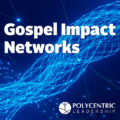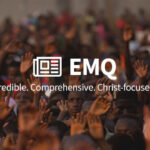BY DR. GRAHAM HILL
(BAPTIST MISSION AUSTRALIA)
A PCL WHITE PAPER
“Mission is from everywhere to everywhere, and from everyone to everywhere.” This idea encapsulates the principle of polycentric missiology. Mission work is no longer merely from the ‘Christian West to the rest’. Instead, Christian mission can and does emanate from all parts of the globe to all parts of the globe. Christianity is global, every culture and region sends and receives missionaries, and the Good News of the Christian faith is shared cross-culturally in all directions.
“Polycentric mission recognizes that God’s mission is not limited to a single organization or group but is a collaborative endeavour involving diverse individuals, churches, and communities, each contributing their unique gifts and perspectives.” – David Bosch (2011).
This polycentric approach is reshaping Christian ministry and mission. But where did it come from? Who are the influential thinkers in the field of polycentric scholarship? How do we put polycentric approaches into practice?
You can skip to the end of this post if you want to read about how you can put polycentric approaches into practice in Christian ministry and mission. But I encourage you to read and reflect on the background of the polycentric approach first.
Polycentricity in Nature and Humanity
Polycentricity is present in natural and human-made environments. Below are a few examples:
Natural Environments:
Ecosystems: A classic example of polycentricity in the natural world is an ecosystem where multiple species interact in a network of relationships, each with their own roles, behaviours, and influences on the system. No single species controls the ecosystem; it results from interactions among many activity centres.
Human Brain: The human brain is another excellent example. It is divided into several different regions, each responsible for a different function. Yet these parts communicate and cooperate, producing a unified consciousness and coordinated physical activity.
Genetic Networks: In genetic networks, multiple genes, regulatory elements, and biochemical pathways interact in complex ways to determine the characteristics of an organism. Again, no single “centre” controls everything; it’s a polycentric system.
Human-made Environments:
Internet: The Internet is a clear example of a polycentric human-made system. It is a global network of independent, interconnected devices, servers, and networks. No central authority controls the entire internet; it relies on multiple centres and layers of governance and operation.
Urban Planning: Cities are often polycentric, especially in the modern era. Instead of having a single centre, they may have several “nodes” or “centres” of activity, such as business districts, cultural hubs, and residential neighbourhoods, each with its own identity and purpose.
Polycentric Governance Systems: Polycentric governance, often applied to manage common-pool resources, involves multiple overlapping jurisdictions, each with the authority to make and enforce rules within a specific domain. For example, environmental management often involves local, regional, national, and international authorities, each with its role and responsibilities.
Decentralized Digital Currencies (Cryptocurrencies): Cryptocurrencies like Bitcoin operate on a decentralized, peer-to-peer network where transactions are carried out directly between users without an intermediary. Here, the concept of polycentricity applies as no single authority controls the network.
Decentralized Autonomous Organizations (DAOs): DAOs represent a new way of organizing where governance decisions are made by a community of stakeholders, often using blockchain technology. In this case, the “centre” of power and decision-making is distributed among multiple parties.
These examples demonstrate that polycentricity can be found in various natural and human contexts, where multiple decision-making centres, control, or influence interact to produce outcomes.
Polycentric Approaches are Reshaping all Fields
Polycentric approaches are everywhere these days. Polycentricity, in governance, politics, leadership, business, mission, and Christian ministry, denotes a system where multiple decision-making units, each with autonomous authority and jurisdictions, function independently yet interdependently. Polycentricity decentralises authority, promotes diversity, and fosters a collaborative approach, fostering resilience and adaptability within a system.
Polycentric systems provide decision-making opportunities at multiple scales, fostering the involvement of diverse actors and enabling context-specific solutions to complex problems.
Polycentricity, originating in the Greek word for “many centres,” has emerged as a critical concept across diverse disciplines, symbolising systems with multiple decision-making units functioning independently yet interdependently.
In governance and politics, polycentricity is embodied in federal systems where power is distributed among various levels of government. It challenges the conventional paradigm of centralisation, allowing diverse entities to influence and implement decisions more attuned to local needs and contexts.
In leadership and business, polycentricity can be seen in organisational structures that promote distributed leadership, where decision-making is not concentrated in a single CEO or board but is shared among different branches or teams.
In law, the concept of polycentricity was first introduced by legal scholar Lon Fuller, describing legal disputes that involve several interlocking issues and parties. These issues and possible resolutions form a complex web of interdependent relationships, challenging the traditional one-dimensional litigation process.
In economics, Elinor and Vincent Ostrom expanded on the concept of polycentricity, applying it to managing common-pool resources. They posited that a polycentric system could lead to more effective and sustainable resource management in contrast to centralised or privatised ones.
In political science, polycentric governance has been explored as an alternative to centralised systems, illustrating a structure in which power is distributed among various levels of government. This model offers adaptability, diversity, and resilience, facilitating solutions more attuned to local conditions.
Polycentric urban regions are seen as a counterpoint to traditional monocentric city models in urban studies. Pioneered by scholars like Walter Christaller and August Lösch, this concept denotes urban areas with multiple activity centres, reflecting modern cities’ complex, networked nature. These multiple centres potentially enhance the region’s economic strength, resilience, and sustainability.
Finally, in mission and ministry contexts, polycentricity emphasises a cooperative, collaborative approach where multiple mission agencies or churches work towards a common goal, each with unique strengths and calling. It acknowledges the varied gifts and roles within the body of Christ, as described in 1 Corinthians 12, and fosters unity in diversity. A polycentric approach in Christian ministry allows various autonomous yet interdependent ministries within the church. This can facilitate more nuanced and locally relevant expressions of faith, enhancing the church’s overall witness and service to the world. In missiology and Christian ministry, polycentricity emphasises the diverse gifts and roles within the body of Christ. It fosters unity in diversity, promoting a cooperative approach where multiple churches or mission agencies each work autonomously yet collaboratively towards a common goal.
Thus, across different disciplines, polycentricity offers an alternative lens to explore, understand, and respond to the complexity and interdependence inherent in modern societies and systems.
Contributions to Polycentricity: The Seminal Work of Elinor and Vincent Ostrom
Elinor and Vincent Ostrom are seminal figures in the field of polycentricity, expanding its scope beyond law and urban studies to include governance and political economy. They identified polycentricity as a versatile tool for understanding complex systems where many decision-making units operate autonomously but interactively.
In the realm of governance, Vincent Ostrom viewed polycentric systems as an alternative to traditional centralised systems. His seminal work, “The Intellectual Crisis in American Public Administration” (1973), conceptualised governance as a polycentric system with multiple autonomous decision-making centres. He argued that these systems provided more effective governance by allowing diverse entities to make decisions, increasing adaptability and resilience.
Elinor Ostrom, on the other hand, applied polycentricity to the management of common-pool resources in her influential book, “Governing the Commons” (1990). Challenging the then-dominant theories advocating state control or privatisation, she demonstrated how polycentric systems involving local communities could lead to more effective and sustainable management of shared resources. Her work made her the first woman to win the Nobel Prize in Economic Sciences in 2009.
Polycentricity allows for experimentation, learning, and adaptation, as it enables different units to try out various strategies and learn from the successes and failures of others.
Their pioneering work provided valuable insights into how polycentric systems can operate and succeed, prompting further exploration in several other fields. The Ostroms’ emphasis on the benefits of polycentricity, such as diversity, adaptability, and resilience, resonated widely and ushered the concept into mainstream academic discourse. Their empirical research provided robust evidence of the efficacy of polycentric systems, fostering a deeper understanding of the complexities of real-world governance and economic systems. Today, Ostroms’ polycentric approach shapes how scholars and practitioners approach complex systems and problems.
Vincent Ostrom: “The Intellectual Crisis in American Public Administration” (1973)
An influential political scientist, Vincent Ostrom, contributed substantially to developing polycentricity, applying the concept to analyse governance systems. His critical work, “The Intellectual Crisis in American Public Administration” (1973), profoundly explores polycentric public administration and governance approaches.
In this seminal work, Ostrom critiques the then-dominant paradigms in American public administration, which were primarily influenced by Newtonian mechanics and viewed governmental functions in a linear, hierarchical manner. This administration model emphasised centralisation and uniformity, leading to ‘one-size-fits-all’ policies that often failed to adequately address local needs and conditions.
In contrast, Ostrom proposed a polycentric approach to public administration, drawing inspiration from fields as diverse as biology, cybernetics, and institutional economics. He used polycentricity to describe a system where many independent units take action. Each of these units is autonomous, making its own decisions and enforcing its rules, but also interacts with other units, adapting and learning in the process. This leads to a more organic, dynamic system of governance, which can respond to local variations and challenges more effectively.
Ostrom’s writings advanced polycentricity as an alternative to centralised authority, demonstrating how a system with multiple decision-making centres can enhance resilience, adaptability, and innovation. He argued that such polycentric systems could better leverage local knowledge and capacity, leading to more effective and equitable outcomes.
Ostrom’s work significantly broadened the scope of polycentricity, taking it beyond its earlier applications in law and urban studies and highlighting its relevance to public administration and governance. His innovative ideas continue influencing scholars and practitioners, providing a vital framework for understanding and improving governance systems in an increasingly complex world.
Elinor Ostrom: “Governing the Commons” (1990)
Elinor Ostrom made significant contributions to the concept of polycentricity, mainly through her application of the approach to the management of common-pool resources (CPRs) – resources that are shared by a community and susceptible to overuse, like fisheries, forests, and groundwater basins.
In her groundbreaking book “Governing the Commons” (1990), Ostrom challenged the prevalent theory known as the “tragedy of the commons,” which held that common resources would inevitably be depleted in the absence of external regulation or privatisation. Instead, she demonstrated that communities themselves, given the right conditions, can effectively manage CPRs and avoid this tragedy. Her research included case studies from around the world where local communities successfully managed shared resources over long periods.
Polycentricity promotes the development of trust, reciprocity, and shared norms among actors, which are crucial for effective cooperation and the resolution of collective action problems.
Ostrom presented a polycentric approach to managing these resources, arguing that a single central authority does not always effectively govern commons. Instead, she illustrated how multiple governing authorities at different scales, each with their own rules and enforcement mechanisms, could coexist and effectively manage shared resources. This polycentric system allows for more adaptability, local problem-solving, and resilience.
Elinor Ostrom was awarded the Nobel Prize in Economic Sciences in 2009, making her the first woman to receive this honour. The award recognised her analysis of economic governance, especially the governance of the commons. She provided empirical evidence demonstrating how community self-governance of common-pool resources can lead to effective and sustainable outcomes, fundamentally transforming how we understand shared resource management.
Polycentric systems empower local actors and communities, enabling them to play an active role in decision-making processes and fostering a sense of ownership and responsibility for the sustainable management of shared resources.
Her work has had a profound impact on the fields of economics, political science, and environmental policy, proving influential in both academia and policy-making, particularly in shaping the discourse around environmental sustainability and resource management.
Polycentric Approaches to Christian Ministry: The Influence of Lesslie Newbigin, John V. Taylor, and Alan Roxburgh
Prominent scholars and thinkers writing about polycentric Christian ministry and leadership include Lesslie Newbigin, John V. Taylor, and Alan Roxburgh.
Lesslie Newbigin, a British theologian and missionary, advocated for a polycentric approach to Christian missions. In his view, the church’s mission is not directed from a single centre but involves a global partnership where each local church contributes to the broader mission. This challenges the traditionally Western-centered view of Christian mission and asserts the importance of locally relevant expressions of faith. Newbigin’s thinking impacted approaches to Christian ministry too.
John V. Taylor, another British missionary and bishop, contributed to the polycentric Christian leadership concept in his book “The Go-Between God.” Taylor speaks about the Holy Spirit enabling every Christian to participate in the mission of God, suggesting a shift from a hierarchical leadership model to a more distributed, polycentric approach.
Alan Roxburgh, a Canadian pastor and consultant, has also been influential in developing polycentric approaches to ministry. Roxburgh views the church as a polycentric network where various ministries can exist autonomously yet interdependently, each bringing its unique contribution to the church’s overall mission.
In polycentric ministry, the focus is on empowering and equipping every member of the body of Christ to actively participate in the mission of God, creating a shared responsibility and a vibrant network of relationships.
These scholars highlight the potential benefits of a polycentric approach to Christian ministry and leadership. By decentralising authority and enabling diverse expressions of faith, polycentricity can facilitate more contextually relevant and effective ministry. It emphasises the importance of mutual cooperation and interdependence among different ministries or churches, reflecting the biblical image of the church as the body of Christ, where each part has its unique function and significance.
Moreover, a polycentric approach to leadership shifts the focus from individual leaders to the entire Christian community, recognising the potential of every member to contribute to the church’s mission. This is closely aligned with the New Testament teaching on spiritual gifts, where every Christian is seen as gifted and called to participate in God’s work (1 Corinthians 12). It can also foster a sense of ownership and engagement among church members, enhancing the church’s overall health and effectiveness.
Finally, in a polycentric approach, the diversity within the global church is not seen as a problem to be solved but as a strength to be celebrated. It allows for the expression of various cultural and theological perspectives, contributing to a more comprehensive and nuanced understanding of the Christian faith. This enhances the church’s global witness and fosters learning and mutual enrichment among different Christian communities.
It should be noted that while a polycentric approach offers significant potential benefits, it also presents challenges, such as maintaining unity and doctrinal integrity amid diversity. Therefore, its implementation requires wisdom, discernment, and a commitment to the core tenets of the Christian faith.
Polycentric Approaches to Christian Mission: The Influence of Andrew Walls, Lamin Sanneh, Lesslie Newbigin, Allen Yeh, and Joseph Handley
Polycentric Christian missiology is a relatively emerging field. Theologians, missiologists, and scholars like Andrew Walls, Lamin Sanneh, and Lesslie Newbigin have been influential in shaping the understanding of mission from the Majority World, cross-cultural exchange, and contextualisation, which lay the groundwork for polycentric discussions.
Andrew Walls is a missiologist and historian of significant reputation. Walls has emphasised the shift of Christianity’s centre to the Global South. He recognises the shift from a monocentric to a polycentric model in global Christianity, highlighting the contributions of non-Western Christianity.
Lamin Sanneh was a historian and World Christianity scholar. Sanneh argued for the importance of vernacular translations in Christian missions. His work, insisting that Christianity is a translatable faith, provides a significant basis for polycentric approaches.
Lesslie Newbigin’s work focuses on contextualising the Gospel, considering culture and community in missiology. This contextual focus aligns with polycentric models, which value the plurality of Christian expression.
Polycentric Christian missiology represents a shift from a Eurocentric or Western-centric model of mission to an approach that recognises multiple centres of influence, understanding, and propagation of the Christian faith. This perspective acknowledges the contribution of Christians from different cultural, social, and geographical backgrounds.
Andrew Walls, a key figure in this domain, posits that the new centres of Christianity reside in the Global South (Africa, Latin America, and parts of Asia). His thinking shifts the narrative from the traditional north-to-south missionary activity to the recognition of South-to-North influence and South-to-South and North-to-North dynamics. Christianity is no longer the domain of a single cultural or geographical centre; it is a multi-faced expression of faith shaped by various global voices.
Lamin Sanneh adds to this by highlighting the translation principle in Christian missions. He argues that the Gospel is not locked to a specific culture or language but can be translated and contextualised to different cultures without losing its essence. This is a crucial element in polycentric missiology, suggesting that Christianity belongs not to a particular culture or language but to the global church with its myriad cultural expressions.
Lesslie Newbigin, though not explicitly addressing polycentrism, contributes to its understanding by emphasising cultural contextualisation. His work on the Gospel in a pluralistic society is an essential foundation for polycentric missiology. According to Newbigin, each culture extracts unique aspects of the Gospel’s truth.
Recently, Allen Yeh and Joseph Handley have published books on polycentric missiology. Their books include “Polycentric Missiology: 21st-Century Mission from Everyone to Everywhere” (Allen Yeh) and “Polycentric Mission Leadership: Toward A New Theoretical Model for Global Leadership” (Joseph Handley).
Allen Yeh examines five events that shaped our understanding of polycentric missiology: The Edinburgh 1910 World Missionary Conference, Tokyo 2010, Edinburgh 2010, Cape Town 2010, 2010Boston, and CLADE V (San José, 2012).
Joseph Handley explores models for global, polycentric mission leadership. Joseph Handley explores models for global, polycentric mission leadership. Joseph’s dissertation (and, to some degree, the book that flowed out of it) was the first to ground the idea of polycentric mission in leadership theory. To my knowledge, no other work has tested the idea theoretically for leadership. There are many studies of polycentricity in the fields of missiology, history, governance, etc., but Joseph was the first to test polycentricity for validity within leadership theoretical paradigms.
In summary, a polycentric approach to Christian missiology and mission moves away from a unidirectional, western-centred view, emphasising that the Gospel can be shared, received, and contextualised in various cultural settings worldwide. This approach fosters a greater appreciation for cultural diversity and collaboration in global Christianity, acknowledging the dynamic interaction between culture and faith. The work of Walls, Sanneh, and Newbigin offers valuable insights into this shift, highlighting the multi-faced, translated, and contextual nature of Christianity.
The Munich School of World Christianity and Klaus Koschorke’s Contributions to Polycentric Missiology
The Munich School of World Christianity, spearheaded by scholars such as Klaus Koschorke, has been instrumental in shaping a new understanding of Christian mission from a polycentric perspective. Contrasting the traditional Eurocentric models, the polycentric approach recognizes multiple, equally valid Christian centres worldwide, opening doors for a more inclusive, diverse, and equitable global Christian community.
Klaus Koschorke, a German historian and Professor of the History of Christianity in the Non-Western World at the University of Munich, has been a pivotal figure in the Munich School. His work fundamentally critiques Eurocentric perspectives, emphasizing the necessity to recognize multiple centres of Christianity. Koschorke advocates a more pluralistic understanding of global Christianity, underscoring the vital contribution of non-Western churches to the broad narrative of Christian history.
The Munich School, under Koschorke’s guidance, has exerted considerable influence on how a polycentric mission is understood. It has emphasized mutual dialogue and exchange among diverse Christian traditions, reinforcing the concept of global Christianity not as a Western religion spread to other parts of the world but as a dynamic faith continuously reinterpreted and shaped by various cultural contexts. This shift in perspective is intrinsic to the polycentric mission, demonstrating that Christianity is not owned or controlled by any one culture but is a global faith that takes on different forms in different contexts.
Koschorke’s significant contribution to the polycentric mission lies in his focus on the “intercultural translatability” of Christianity and recognition of non-western forms of Christianity. He contends that Christianity, as a global faith, should not only be open to but should also expect multiple interpretations and expressions shaped by various cultures and societies. His research highlights the global networks of communication and exchange among Christians, indicating that the centre of Christianity is not exclusively the West, but rather, these centres are scattered and dispersed across the globe.
Koschorke’s work has provided a solid foundation for understanding Christianity as a truly global and polycentric faith. The Munich School, in turn, continues to influence the global perception of Christian mission, prompting a departure from Eurocentric views towards a more inclusive, diverse, and equitable polycentric understanding of global Christianity.
The influence of the Munich School of World Christianity and Klaus Koschorke’s work has been pivotal in shaping a polycentric approach to mission. This shift has brought a more balanced and equitable understanding of global Christianity and enhanced mutual dialogue and appreciation among different Christian traditions worldwide. The polycentric approach, thus, is a crucial step towards acknowledging and celebrating the global and pluralistic nature of Christianity.
Respecting the Centres
Jay Mātenga notes a problem with much of the conversation about polycentric missions – we need more conversations about how we respect the centres. In a Facebook conversation with me, Jay Mātenga writes, “In global missions, one of the challenges we face is that centres intersect and interact often in inequitable ways. That is, authority from an outside centre impacts the authority of a local centre. It is all very well when centres agree to collaborate to the best of their contributions and find an equilibrium to do so. Still, when you get a clash of perspectives, that relationship needs to be navigated well, and, in my opinion, the most local centre should lead (that is, those most impacted by the decisions made should have a greater decision-making influence).” Jay’s article “Centring the Local: the Indigenous Future of Mission” explores these and associated issues.
In polycentric missions, respect for various centres can be achieved by fostering inclusive collaboration, recognizing local expertise and perspectives, promoting equitable decision-making processes, and addressing power imbalances. Here are some key considerations:
Inclusive collaboration: Polycentric missions should prioritize active participation and engagement from all relevant centres, ensuring that diverse voices and perspectives are heard and respected. This can be achieved through open dialogue, regular communication channels, and inclusive decision-making platforms.
Recognizing local expertise: Each centre brings its unique knowledge, skills, and experiences to the mission. Respecting the centres involves acknowledging and valuing the expertise and contributions of local actors. This requires creating opportunities for local centres to share their insights, contribute to problem-solving, and lead initiatives in their respective areas of influence.
Equitable decision-making: Polycentric missions should strive for decision-making processes that are fair and inclusive. It is important to ensure that decision-making power is not concentrated solely in one centre but distributed among all stakeholders. Decision-making structures should consider the impact on all centres involved and prioritize the input and influence of those most affected by the decisions.
Addressing power imbalances: Power dynamics can significantly impact the relationships between different centres. Polycentric missions must actively address and mitigate power imbalances by fostering transparent and accountable governance mechanisms. This includes ensuring that decisions made by external centres do not undermine the authority and autonomy of local centres and actively working towards balancing power dynamics in a way that promotes equitable collaboration.
Overall, respecting the various centres in polycentric missions requires an ongoing commitment to inclusive and participatory processes that prioritize local leadership, recognize diverse expertise, and address power imbalances. By doing so, polycentric missions can navigate clashes of perspectives, foster effective collaboration, and work towards equitable outcomes that benefit all centres involved.
A Summary of Polycentric Christian Leadership and Ministry
Polycentric Christian leadership and ministry is a model that values and integrates the unique perspectives, insights, and practices of multiple cultural and geographical centres within Christianity.
“Polycentric approaches to ministry emphasize collaboration and partnership among churches, organizations, and individuals, fostering unity and synergy in pursuing common goals and serving the needs of communities.” – Craig Van Gelder & Dwight J. Zscheile (2011).
Here’s a summary of the theory and practice of polycentric Christian leadership and ministry::
Decentralised Leadership: Polycentric leadership is not centred on a single authoritative figure or group. Leadership roles are shared among multiple people or groups, often representing various cultural or geographical contexts.
Global Influence: This model recognises that impactful Christian leadership and ministry exist outside traditional Western contexts in the Global South and East.
Mutual Learning: In a polycentric model, there’s an emphasis on mutual learning and exchanging ideas between different ‘centres’ of Christianity.
Contextual Ministry: Polycentric ministry stresses the importance of contextualising the Gospel message to a specific cultural or societal context, recognising that how Christianity is practised and understood can vary greatly.
Recognition of Diversity: This model appreciates the diversity in Christian beliefs, practices, and expressions across different cultures and societies.
Interdependence: Polycentric leadership promotes interdependence rather than dependence. Each ‘centre’ contributes uniquely to the whole, rather than one centre controlling or providing for the others.
Equity and Equality: Polycentric leadership seeks to promote fairness and equality, breaking down hierarchies often found in traditional models of Christian leadership.
Adaptive Change: Because polycentric models value diverse input and context, they often encourage adaptive change over technical change, i.e., solutions tailored to specific contexts rather than one-size-fits-all approaches.
Shared Decision-Making: Polycentric leadership implies shared decision-making processes, ensuring each centre’s voice is represented and considered in final decisions.
Unity in Diversity: The ultimate goal of polycentric leadership and ministry is to achieve unity in diversity – creating a unified Christian community that appreciates, learns from, and celebrates its diverse expressions and understandings of faith.
A Summary of Polycentric Christian Missions and Missiology
Polycentric Christian missiology recognises multiple centres of Christian influence and understanding worldwide. Here’s a summary of its theory and practice:
Multiple Centers: Unlike a Eurocentric or Western-centric model, polycentric missiology sees multiple centres of Christian influence across the globe.
Cultural Contextualisation: The Gospel is adapted to different cultures, languages, and societies without losing its core message. This recognises the translatable nature of the Christian faith.
Majority World Influence: There is a shift of Christian influence from the West to the Majority World (Global South), acknowledging the contribution and leadership from Africa, Asia, and Latin America in Christian mission.
Mutual Interchange: There’s an emphasis on mutual exchange and learning among the different ‘centres’ of Christianity, fostering a global conversation.
Translation Principle: Christianity is not tied to one culture or language, and the Bible can be translated and understood within different cultural contexts, a concept advanced by Lamin Sanneh.
Vernacular Theologies: Theologies and interpretations of the Gospel that arise from various cultural and societal contexts are acknowledged and valued.
Indigenous Leadership: There’s a recognition and encouragement of local leadership in mission, rather than leadership being predominantly Western.
Collaboration: There’s an emphasis on collaboration between different Christian ‘centres’. Mission is seen as a shared effort of the global church rather than the task of one particular group.
Recognition of Diversity: This approach appreciates the diversity within Christianity and the unique expressions of faith across different cultures and societies.
Holistic / Integral Approach: Polycentric missiology often takes a more holistic approach to mission, considering the social, economic, and environmental contexts in which mission occurs, reflecting the challenges and contexts represented within a global church.
Practical Ways We Can Apply Polycentric Approaches to Ministry and Mission
Here are practical ways that churches, pastors, Christian mission organisations, and missionaries can apply polycentric principles and approaches:
Mutual Partnerships: Form partnerships with churches or mission organisations from different cultural and geographical contexts for mutual learning and support.
Cultural Exchange Programs: Encourage cultural exchange programs where missionaries from different centres of Christianity can visit and learn from each other.
Diverse Leadership: Include leaders from diverse backgrounds in decision-making processes, fostering leadership that reflects global Christianity.
Language and Culture Study: Encourage the study of different languages and cultures among missionaries, ministry teams, and pastors to facilitate cross-cultural communication and understanding.
Contextual Communication: Practice and promote preaching, teaching, and communication sensitive to the audience’s cultural context.
Inter-Cultural Training: Train pastors, missionaries, and church members about different cultures, fostering respect and understanding.
Promote Indigenous and First Nations Theologies: Encourage studying and promoting theological perspectives from different cultures, not just Western theology.
Financial Equity: Seek financial equity among churches or organisations from different regions, sharing resources and support.
Vernacular Worship: Incorporate elements of worship from different cultures in church services, including music, prayers, and liturgy.
Local Leadership: Prioritise the development and empowerment of local leadership in mission fields, reducing dependency on foreign missionaries.
Global Prayer: Regularly pray for the worldwide church, highlighting specific issues or events from different ‘centres’ of Christianity.
Global Missions Conferences: In global missions conferences, ideas and experiences can be exchanged.
Collaborative Projects: Collaborate on projects or initiatives that involve teams from different centres of Christianity.
Diversity in Literature: Utilise Christian literature from different cultural and theological backgrounds in Bible studies or small groups.
Acknowledge Historical Mistakes: Acknowledge and learn from historical mistakes in missions where one culture dominates others.
Foster Dialogue: Create platforms for dialogue about cultural differences and similarities, promoting mutual understanding.
Exchange of Ideas: Encourage exchanging ideas for church programs and mission strategies from various cultural contexts.
Support Local Initiatives: Support and learn from local initiatives in mission fields rather than imposing external strategies.
Storytelling: Encourage sharing stories about God’s work in different parts of the world.
Local Solutions: Encourage and support the development of local solutions to local problems, acknowledging that the local church often understands its context best.
Practical Ways We Can Apply Polycentric Approaches to Theology and Missiology
Here are practical ways theologians and missiologists can apply polycentric principles and approaches:
Diverse Sources: Use theological sources from different cultures and geographical locations, not just Western or traditionally dominant sources.
Cross-Cultural Studies: Encourage and engage in studies of Christianity as it is practised in various cultural and social contexts across the globe.
Mutual Exchange: Foster a mutual exchange of ideas with theologians and missiologists from different cultural backgrounds and experiences.
Promote Indigenous and First Nations Theologies: Encourage, study, and disseminate theologies that have emerged from Indigenous Peoples and First Nations contexts.
Language Learning: Learn different languages to read theological works in their original language and understand their cultural nuances.
Collaborative Research: Engage in joint research projects with theologians and missiologists from different cultural contexts.
Contextual Understanding: Incorporate an understanding of the local context when studying and developing missiological strategies or theological interpretations.
Holistic / Integral Approach: Take a holistic approach to missiology, considering cultural, societal, economic, and environmental factors.
Teaching and Mentoring: Include polycentric principles in education and mentoring, preparing the next generation of theologians and missiologists to think globally and contextually.
Publication and Presentation: Publish and present research in diverse forums, not just Western academic journals or conferences. This spreads the reach of research and opens up dialogue with a broader spectrum of global theologians and missiologists.
Conclusion: Polycentric Approaches are Essential and Renewing
Polycentric approaches are essential for Christian ministry, leadership, mission, theology, and missiology because they better reflect the global, diverse nature of the body of Christ. The shift from a Western-centric view to a more polycentric one acknowledges Christians’ vital contributions and unique perspectives from different cultural, social, and geographical backgrounds. This approach fosters a more equitable, diverse, and interconnected global Christian community, enriching our understanding of the Gospel through varied cultural lenses.
“Polycentric mission shifts the focus from the ‘center’ or headquarters to the periphery, engaging with local contexts and empowering indigenous leaders and communities to take ownership of the mission and contextualize it effectively.” – Samuel Escobar (2018).
Polycentricity encourages mutual learning, respect, and partnership among different ‘centres’ of Christianity. As such, polycentric principles lead to a more authentic, inclusive, and effective practice of ministry, leadership, mission, and theological reflection, demonstrating the universality of the Christian faith while appreciating its diverse expressions.
Polycentric approaches can bring new life, renewal, and regeneration into the Christian faith by fostering a fresh understanding of the Gospel through the lens of diverse cultures and contexts. Acknowledging the multiplicity of ‘centres’ of Christianity, it celebrates the richness and depth of Christian expression around the globe, enabling a vibrant exchange of ideas, practices, and perspectives. This breathes new life into communities as they learn from each other, rediscover aspects of the Gospel through different cultural lenses, and gain a broader, more nuanced understanding of the Christian faith. This renewal can stimulate spiritual growth, generate creative approaches to ministry and mission, and inspire a more profound commitment to unity in the body of Christ.
The polycentric model, therefore, plays a crucial role in the continual regeneration of the global church, making it more inclusive, dynamic, and reflective of its universal yet diverse nature.
Further Reading
Here’s some further reading on a polycentric mission and ministry (arranged alphabetically by surname).
Samuel Escobar:
Escobar, S. (2013). “The New Global Mission: The Gospel from Everywhere to Everyone.”
Kirk Franklin:
Franklin, K. (2015). “A Case Study: A Journey of Leading in Polycentric Theory and Practice in Mission.”
Franklin, K., & Niemandt, N. (2016). “Polycentrism in the Missio Dei.”
Joseph Handley:
Handley, J. (2022). “Polycentric Mission Leadership: Toward A New Theoretical Model for Global Leadership.”
Klaus Koschorke:
Koschorke, K. “Transcontinental Links: A History of the Worldwide Network of the Apostolic Faith, c. 1906–1930”.
Lesslie Newbigin:
Newbigin, L. (1989). “The Gospel in a Pluralist Society.”
Newbigin, L. (1986). “Foolishness to the Greeks: The Gospel and Western Culture.”
Alan Roxburgh:
Roxburgh, A. J. (2015). “Joining God, Remaking Church, Changing the World: The New Shape of the Church in Our Time.”
Roxburgh, A. J., & Romanuk, F. (2006). “The Missional Leader: Equipping Your Church to Reach a Changing World.”
Lamin Sanneh:
Sanneh, L. (2009). “Translating the Message: The Missionary Impact on Culture.”
Sanneh, L. (2003). “Whose Religion is Christianity? The Gospel Beyond the West.”
John V. Taylor:
Taylor, J. V. (2002). “The Go-Between God: The Holy Spirit and the Christian Mission.”
Taylor, J. V. (2001). “The Primal Vision: Christian Presence Amid African Religion.”
Andrew Walls:
Walls, A. (1996). “The Missionary Movement in Christian History: Studies in the Transmission of Faith.”
Walls, A. (2002). “The Cross-Cultural Process in Christian History: Studies in the Transmission and Appropriation of Faith.”
Allen Yeh:
Yeh, A. (2016). “Polycentric Missiology: 21st-Century Mission from Everyone to Everywhere.”
About the Author
Dr. Graham Joseph Hill

Graham Joseph Hill (PhD) is State Leader for Baptist Mission Australia (Western Australia). He was formerly the Principal of Stirling Theological College (Melbourne), the Vice-principal of Morling College (Sydney), and an Associate Professor at the University of Divinity, Australia. Graham is an ordained and accredited minister with the Baptist Churches of Australia. He has planted and pastored churches and been in ministry since 1988. Graham is the author or editor of 13 books. He also directs The Global Church Project. Graham writes at grahamjosephhill.com. See ORCID publication record: https://orcid.org/0000-0002-6532-8248.
More Information
- This article was reposted with permission from Dr. Graham Joseph Hill.
- Download Whitepaper (PDF)












